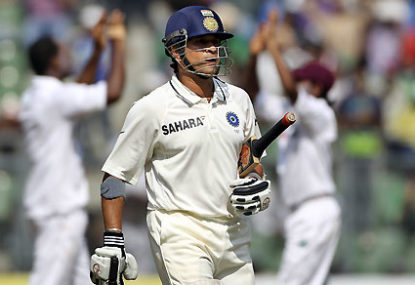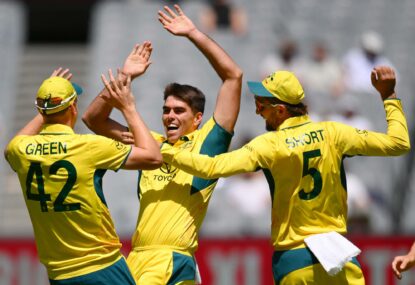Whenever Sachin Tendulkar retires, which one imagines will be by the end of this year, it will mark the end of an era when a group of special cricketers played the game.
The era started in the mid 80s, which saw the emergence of a revitalised Australia cricket team led by Allan Border and then Mark Taylor, to reach the top of the ranks in both Test and one-day cricket.
Not only were both great captains and leaders, they were also brilliant batsmen. Border would be known for his gritty style and fighting spirit while Taylor was known for his cheerful attitude alongside his elegant style of batting.
The Australian captains to follow would break all kinds of records, in Steve Waugh and Ricky Ponting. Waugh would become the most successful captain in the history of Test cricket in terms of win-loss percentage, with 72 percent, while Ricky Ponting would become the most successful captain in terms of games won in Test and ODI cricket, though his Test record has since been broken by Graeme Smith with 49.
As players, Waugh was known for his ability to grind and fight his way through tough periods, while Ponting was known as a fierce competitor, arrogant and stubborn who only played for one reason, to win for Australia.
It was the press forward, then swivel onto the back foot to play one of the more fabulous pull shots in world cricket that made Ponting so great to watch, while for Waugh it was the determination, spirit and fight.
The two bowlers who really changed the face of spin bowling were Shane Warne and Muttiah Muralitharan. Both broke all kinds of records and had their own rivalry in number of wickets. Warne was a one-of-a-kind player. He was the fast bowler of leg spin, always wanting to get into the batsmen’s heads and sledging on the field. In the end he would win just about every battle, which made him so great.
Like Warne, Murali was also feared by batsmen around the world. He would end up with the most wickets taken by any bowler, most five-wicket innings, and most ten-wicket matches. Although both careers were marred by controversy early on, they were the spin kings of cricket.
Then came the fast bowlers. Curtley Ambrose and Courtney Walsh were the West Indian bowling duo that literally destroyed batting line-ups all over the world. They were tall and intimidating. It wasn’t until a defiant Steve and Mark Waugh stood strongly to guide Australia to a historic series victory in the West Indies in 1995 that they were stared down.
Elsewhere on the globe, we saw the emergence of Glenn McGrath, Allan Donald and Brett Lee.
Tall, skinny, and a big sledger at times was Glenn McGrath. Never was he express pace nor did he swing the ball like Wasim Akram but every ball was in the right area. He would get extra bounce and hit the seam, then when the ball got older, he would take advantage of reverse swing.
Lee and Donald were the fast bowlers who put full effort into every ball. Capable of bowling 145km/h consistently, both were fast, aggressive and at times scary. Lee’s bouncer caused many injuries, and even ended careers, most notably in Alex Tudor’s case, but he was a kind-hearted player of the game.
Alec Stewart and Andy Flower were great keepers but there was none better than the one-in-a-lifetime Adam Gilchrist. When on song, he was the most destructive batsman in world cricket. He broke all kinds of records, with the most runs and best average by a keeper-batsman in Test and ODI cricket, the most dismissals in ODI cricket, and at one stage the most dismissals in Test cricket before that was broken by Mark Boucher.
He also holds the record for the second-fastest hundred in Test cricket, and as the only player ever to hit 100 sixes in a test career. Gilchrist changed how a ‘keeper played and his tendency to walk without waiting for the umpire’s decision was praised and applauded.
His ODI opening partner Matthew Hayden was also a rare player. It took seven years for Hayden to cement his spot in the Australian side but when selectors stuck with him, it paid massive dividends.
The 549 runs he scored in the 2001 Border-Gavaskar Trophy series in India sparked his revival as an international cricketer. He would go on to score over 1000 runs in five consecutive years from 2001-2005, the first man to achieve the feat, and he would record once a world record 380 against Zimbabwe in 2003 in Perth.
Hayden was a massive unit, a destructive ball striker and at times a beautiful timer.
Statistically, the best batsmen of this modern era would be Jacques Kallis, Brian Lara, Ponting and of course Sachin Tendulkar. The best bowlers would be Warney, Murali, McGrath and Anil Kumble. It was an era where there were so many players you’d go to a game just to see.
It was an era when cricketing gods and legends were made. It was an era where the game changed completely. But the era is coming to a close. The two left standing are Tendulkar and Kallis, and when they retire, it will be time for a new breed of players to mark their names as cricketing greats.
Perhaps they’ll include Michael Clarke, David Warner, Peter Siddle, James Anderson, Graeme Swann, Virat Kohli, AB de Villiers, Alistair Cook, and Graeme Smith. Perhaps their number will be drawn from players yet to come.





































































































